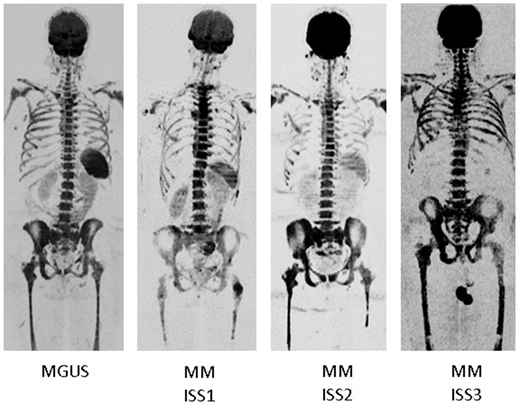Abstract

Background: Whole body medical imaging is an integral component of Multiple Myeloma (MM) evaluation as it reveals bone disease and/or focal lesions. While established imaging techniques, such as PET-CT, are powerful in delineating focal pathologies, they suffer from low specificity when it comes to assessment of diffuse bone marrow (BM) signals. Especially in patients treated with G-CSF, discrimination between malignant and non-malignant BM signals is barely possible. Diffusion-weighted MRI with background suppression (DWIBS) is a novel functional MRI technique which measures water diffusion in vivo. Basically, diffusion of water is more restricted in tissues with high cellularity, making DWIBS a promising tool to investigate malignant diffuse signals. Initially, we searched for an internal reference to classify the level of BM infiltration. We selected the spleen, since it is the abdominal organ with the highest restriction on DWIBS. Unexpectedly, we observed significant heterogeneity in the spleen signal itself including a subgroup of MM patients with total loss of the signal on DWIBS. Perplexingly, these patients suffered from high tumor burden and poor outcome. Here, we report on our strategy to elucidate this phenomenon and to evaluate its clinical value.
Methods: We investigated 295 transplant-eligible newly diagnosed MM patients and 72 cases with monoclonal gammopathy of undetermined significance (MGUS). This study was approved by the institutional review board (#205415). DWIBS was performed on a 1.5 Tesla Philips Achieva scanner. The spleen signal was assessed on DWI and ADC maps by two experienced investigators in consensus read. The Kaplan-Meier method was used for survival analyses. Molecular characterization included fluorescence in situ hybridization, and gene expression profiling of CD138-enriched plasma cells (PCs). Differential gene expression was performed using a threshold of 2-fold expression difference. Wilcoxon or Fisher's exact tests were used to compare the median of a continuous variable or the distribution of discrete variables across groups, respectively. Correlation coefficients were determined using Spearman's rank correlation.
Results: Absence of the spleen signal on DWIBS was a frequent phenomenon in MM, seen in 71/295 (24%) patients. In all of these patients asplenia was excluded using alternative imaging techniques. Lack of a signal was highly positively associated with tumor-load parameters, such as the degree of BMPC infiltration (P=1x10-10) or International Staging System (ISS) 3 (P=0.0001). In contrast, it was not associated with age, gender, or the tumor progression markers gain(1q) and del(17p). Patients with absence of spleen signal experienced unfavorable outcome (hazard ratio of 1.8 for PFS and OS). In order to further investigate the biological underpinnings of this phenomenon we performed a differential gene expression analysis of purified CD138 MM cells. No differentially expressed genes were found between patients with and without spleen signal, suggesting that the absence of the spleen signal mainly reflected increased tumor burden rather than specific tumor features. As a proof of concept, we addressed the spleen signal in individuals with MGUS, and longitudinally in MM patients who presented with absence of the spleen signal at diagnoses. Indeed, in all 78 individuals with MGUS the signal was preserved, and the majority of MM patients showed re-appearance of the spleen on DWIBS during treatment as the tumor burden declined. Interestingly, re-appearance of the spleen was helpful to distinguish between malignant and non-malignant hyperintensities in the BM, making the spleen signal a promising parameter for MM follow-up investigations.
Conclusions: Due to the low frequency of abnormalities affecting the spleen, this organ is often overlooked during abdominal examinations using cross-sectional imaging techniques. Here we show that the spleen signal on DWIBS provides clinically useful information on tumor burden in MM. Moreover, it opens the avenue to distinguish between malignant and reactive BM hypercellularity on imaging in patients receiving treatment. Our observation strongly supports the hypothesis, that the spleen signal is suppressed by a high BMPC involvement. Yet, the reasons for this phenomenon are still elusive.
Roy Choudhury:University of Arkansas for Medical Sciences: Employment, Research Funding. Epstein:University of Arkansas for Medical Sciences: Employment. Barlogie:Dana Farber Cancer Institute: Other: travel stipend; International Workshop on Waldenström's Macroglobulinemia: Other: travel stipend; ComtecMed- World Congress on Controversies in Hematology: Other: travel stipend; European School of Haematology- International Conference on Multiple Myeloma: Other: travel stipend; Celgene: Consultancy, Research Funding; Millenium: Consultancy, Research Funding; Myeloma Health, LLC: Patents & Royalties: : Co-inventor of patents and patent applications related to use of GEP in cancer medicine licensed to Myeloma Health, LLC; Multiple Myeloma Research Foundation: Other: travel stipend. Davies:Amgen: Consultancy, Honoraria; Abbvie: Consultancy, Honoraria; Takeda: Consultancy, Honoraria; Janssen: Consultancy, Honoraria; Celgene: Consultancy, Honoraria. Morgan:Janssen: Research Funding; Bristol-Myers Squibb: Consultancy, Honoraria; Takeda: Consultancy, Honoraria; Celgene: Consultancy, Honoraria, Research Funding.
Author notes
Asterisk with author names denotes non-ASH members.

This icon denotes a clinically relevant abstract


This feature is available to Subscribers Only
Sign In or Create an Account Close Modal